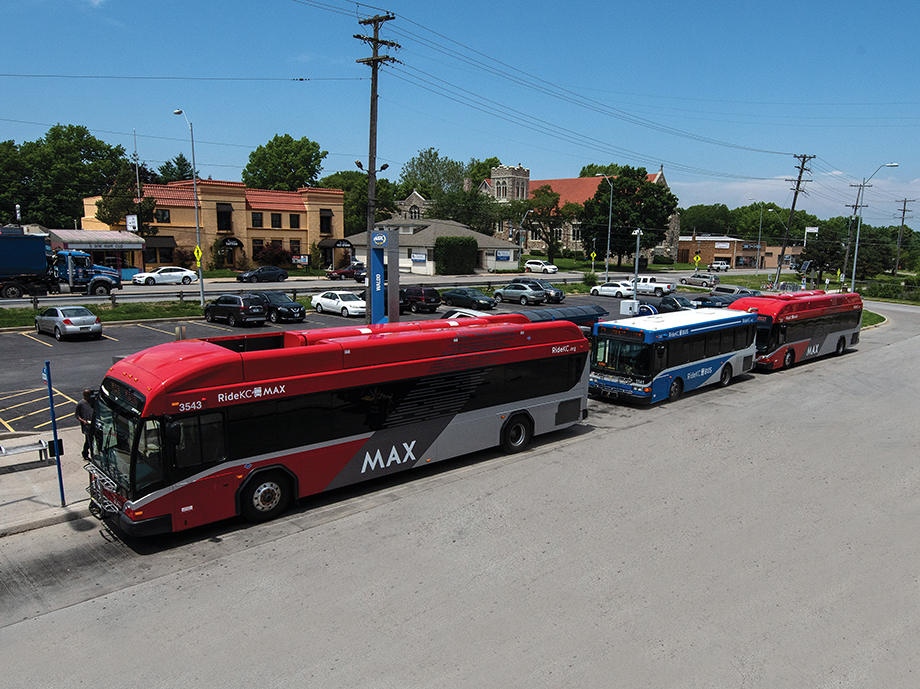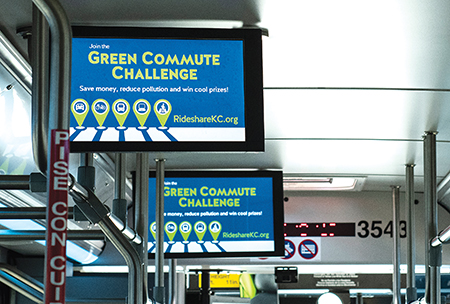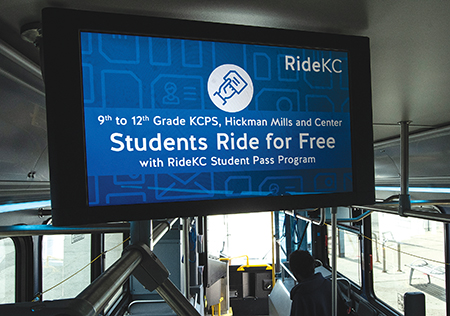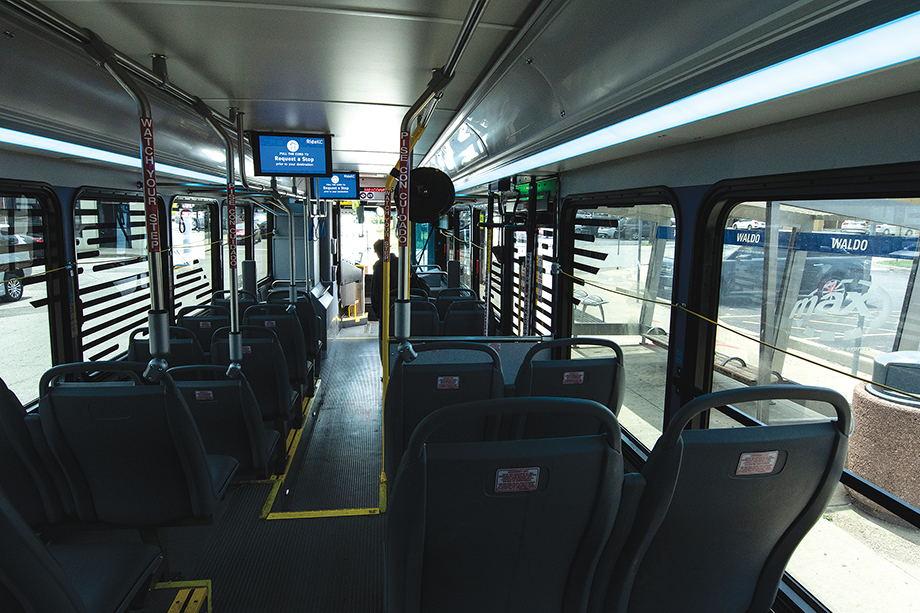
The team at Kansas City Area Transportation Authority (KCATA) considers the agency a leader in Smart City deployment — increasing operational efficiency by continuously rolling out technology and data-gathering tools on the cutting-edge of public transit. To that effect, KCATA has been hard at work on expanding MAX, the city’s Bus Rapid Transit (BRT) line.
 Servicing several busy corridors in Kansas City, MAX offers more frequent service, traffic signal priority for buses, fewer stops, specialized MAX stations and vehicles sporting unique branding.
Servicing several busy corridors in Kansas City, MAX offers more frequent service, traffic signal priority for buses, fewer stops, specialized MAX stations and vehicles sporting unique branding.
Now, as KCATA is constructing its third MAX line on Kansas City’s Prospect Avenue, scheduled to begin service in 2019, the city is taking Smart City deployment to the next level by implementing an integrated INFOtransit system for its passengers on the new 10-mile route.
INFOtransit, by Luminator Technology Group, is a system featuring vibrant, high-definition onboard passenger information screens. More than a next-stop announcement, the system is equipped to display route ladders, public service information, news and weather and advertising; it also provides audio announcements and displays camera feeds from the vehicle’s on-board video security system.
David Johnson, chief strategy officer for the Office of the President & CEO at KCATA, said the agency worked with Luminator and Gillig to ensure that the most recent purchase of MAX vehicles included INFOtransit.
 Relationship and updates
Relationship and updates
KCATA’s relationship with Luminator Technology Group dates back to the agency’s prior relationship with Apollo Video Technology, a mobile video surveillance and information management solutions provider that Luminator acquired in 2017. As an Apollo customer, representatives from KCATA were treated to an INFOtransit demo by Luminator — and they deemed the system an obvious addition.
“We ran a pilot program on an existing vehicle, where we did some upgrades that were planned for our new fleet,” Johnson said. “It involved new vinyl seating, updated interior lighting, and an INFOtransit monitor. We wanted to gauge the riding public’s interest.”
The MAX route will be further enhanced by an assisted wayfinding mobile app, public Wi-Fi, in-station smart kiosks, USB charging ports, and driver barriers for increased safety.
All these upgrades planned for the new fleet comprise a $56 million project. KCATA’s Small Starts creator funded around $30 million, and the rest of the funding came from the agency’s local capital budget for Kansas City, Missouri, which is where the entire route runs.
KCATA is also currently working with Luminator to implement the RoadRunner 4K Mobile Recording System on the new fleet. This will allow the agency to integrate onboard cameras with the INFOtransit screen, allowing live video to be shown to riders.
“It adds security,” Johnson said. “Someone walks onto the bus and doesn’t just see a sign announcing surveillance equipment. They see a live video, and they know the vehicle is not a good place to cause trouble.”

System tech
KCATA has deployed two INFOtransit screens to each of the new buses, all of which use a cellular connection to communicate to KCATA dispatch and administration. The optional cellular connection affords the agency more flexibility in programming the screens.
“The cellular connection is a great option, first because it allows KCATA officials to monitor the system in real time,” Dan Kelleher, vice president of sales for Luminator Technology Group, said. “But it also allows the opportunity for KCATA to put in an impromptu, or ad hoc, message in case of an emergency or urgent event. For example: bridge down, route obstructed, next stop closed, and so on.”
Learning curve
Advertising and public service announcements, Johnson said, were two areas of keen interest for KCATA, particularly because of INFOtransit’s geofencing capabilities. Specific announcements and advertisements are connected to certain locations, as programmed by KCATA.
Luminator representatives did the initial programming of the system’s geofencing. Then, as KCATA designated staff members as INFOtransit programmers, Luminator conducted on-site training for changing announcements and advertisements across the system. Ongoing customer and tech support are offered on an as-needed basis.
The pilot run on a single bus proved invaluable to both Luminator and KCATA in order to provide the correct communication link between the INFOtransit system and the agency’s existing ITS system.
“We learned that we needed to integrate INFOtransit with our ITS by Trapeze Group a little bit more directly, which was handled and now the system is working robustly,” Johnson said. “I’d recommend any agencies considering systems like this to always think in advance about how it will integrate with existing Intelligent Transportation Systems.”

Feedback and the path ahead
Moving forward, Kelleher and Johnson agreed that INFOtransit makes a big difference for KCATA in three key areas: route information, public information and revenue.
Route information is the system’s primary function, and its dynamic route ladders allow for KCATA to customize and adjust based on daily schedules — one route, for example, may have more business-corridor trips on a Monday than it does on a Saturday. Furthermore, new riders feel much more comfortable riding transit when the route ladder is clear about a vehicle’s current position and the next destination. KCATA hopes that by promoting more confidence in its passengers, it will increase total ridership.
As a resource for public information, Kelleher said, the INFOtransit system provides many advantages over printed announcements or even static screens.
“People will look at paper advertisements or announcements, or static screens, and they will read a bit but eventually look away,” he said. “A dynamic, changing interface with audio announcements and geofenced information allows for riders to better absorb important information.”
Finally, because KCATA can associate specific advertisements with specific stops, the agency can structure its advertising fees based on how much traffic a certain stop receives.
Community feedback has so far been largely anecdotal, but exceptionally positive. KCATA’s social media team has noticed an uptick in rider engagement on Twitter regarding the MAX line’s renovations. Many riders are taking pictures of the INFOtransit screens and the new lighting and posting those as well.
The agency is currently conducting a formal customer satisfaction survey and expects to hear more positive reactions to the system later this year.
“People are picking up that this new passenger information system, along with the new seating and lighting, represents an evolution of the MAX brand,” Johnson said. “It puts our agency in a great place for future growth, and it helps cement the community’s reputation as a Smart City.”
